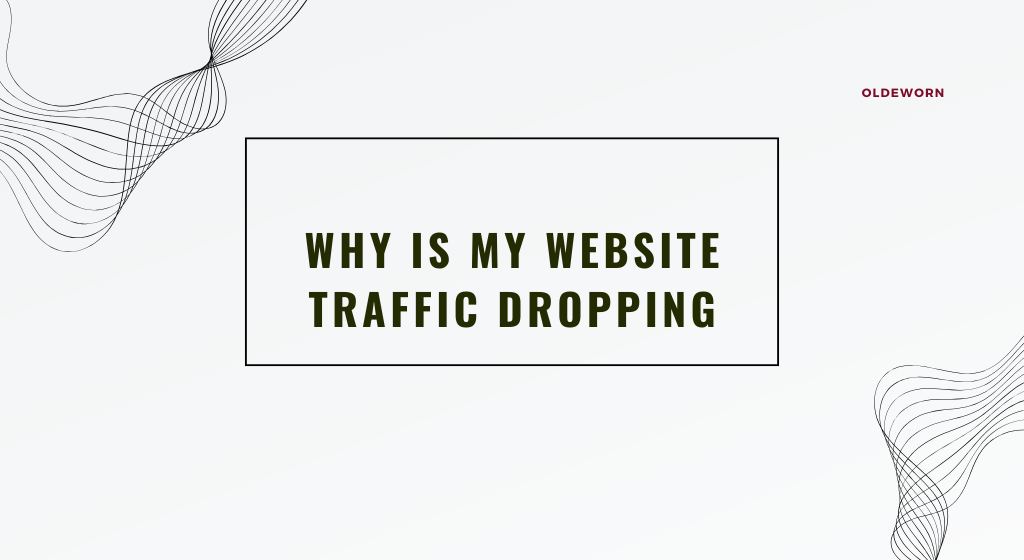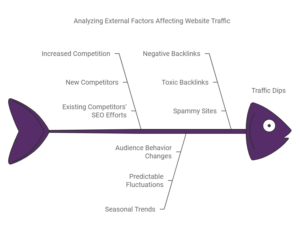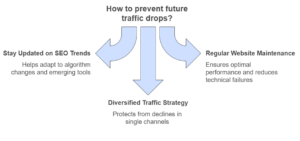In the digital age, website traffic is the lifeblood of online businesses and blogs. But what happens when your once-thriving site starts losing visitors? A sudden or gradual decline in website traffic can feel alarming, but understanding the root causes is the first step toward recovery. Let’s dive deep into why your website traffic might be dropping and how to fix it.
Understanding Website Traffic Decline
The Importance of Monitoring Website Traffic
Website traffic isn’t just a vanity metric; it reflects your online visibility and engagement with your audience. Regularly monitoring your traffic helps you identify patterns, understand user behavior, and spot red flags early. Tools like Google Analytics can provide insights into traffic sources, bounce rates, and user engagement metrics, offering a comprehensive view of your site’s health.
Common Symptoms of Traffic Drop
When traffic drops, the symptoms are usually easy to spot:
- Lower organic search rankings.
- Reduced social media referral clicks.
- Decreased time-on-page and higher bounce rates.
If left unchecked, these issues can severely impact revenue, conversions, and your online presence. But what causes these declines? Let’s explore the technical and content-related reasons behind the drop.
Technical Reasons for Traffic Drops
Website Downtime or Server Issues
If your site is frequently offline, search engines and users will start to lose trust. Check your hosting provider’s uptime stats and ensure your site’s infrastructure is reliable.
Slow Page Load Speeds
In a world where speed matters, slow-loading websites can deter users and rank poorly in search results. Use tools like Google PageSpeed Insights to assess performance and make optimizations, such as compressing images and leveraging browser caching.
Mobile Usability Problems
With mobile devices accounting for over half of all web traffic, any issues with mobile compatibility can lead to significant losses. Ensure your site is responsive, with clear navigation and properly formatted content for smaller screens.
Algorithm Updates and SEO Factors
Google Algorithm Updates
Google frequently updates its algorithms, and major changes can upend rankings overnight. From core updates to changes targeting spammy practices, staying informed is crucial to maintaining traffic.
Keyword Ranking Fluctuations
Keywords that once drove traffic might now perform poorly due to algorithm changes or competitor optimization. Reassess your keyword strategy and use tools like SEMrush to track ranking shifts.
Poor Content Quality or Duplicate Content
Search engines penalize low-quality or copied content. Thin, irrelevant, or overly keyword-stuffed articles won’t rank well, so focus on producing high-quality, unique, and engaging content.
Content-Related Issues
Outdated or Irrelevant Content
Content that’s no longer relevant or fails to align with current trends can hurt your rankings. Regularly updating older posts can help maintain their SEO value and improve engagement.
Inadequate On-Page SEO
On-page SEO factors like meta descriptions, alt tags, and internal linking directly affect your visibility. Optimizing these elements ensures search engines understand and rank your pages appropriately.
Cannibalization of Keywords
If multiple pages target the same keyword, they might compete with each other, reducing their collective ranking power. Consolidate similar content or adjust your keyword strategy to resolve this issue.
External Factors Impacting Traffic
Increased Competition in Your Niche
New competitors entering your space or existing ones ramping up their SEO efforts can cause traffic dips. Analyze your competitors’ strategies and find ways to differentiate your content.
Seasonal Trends or Audience Behavior Changes
Certain industries experience predictable fluctuations in traffic. For example, retail sites might see spikes during holiday seasons and drops afterward. Understanding these trends helps you adjust your expectations and campaigns accordingly.
Impact of Negative Backlinks
Toxic backlinks from spammy sites can harm your domain authority. Use tools like Google Search Console to identify and disavow harmful links.
Fixing the Decline: Strategies to Boost Traffic
Conducting an SEO Audit
An in-depth SEO audit can uncover hidden issues like broken links, outdated content, or underperforming keywords. Regular audits are essential for maintaining a healthy site.
Improving Page Load Speeds and Mobile Usability
A fast, mobile-friendly website is non-negotiable. Streamline your code, minimize JavaScript, and ensure your design is responsive across all devices.
Enhancing Content Quality and Relevance
Content remains king. Create valuable, informative, and engaging articles tailored to your audience’s needs. Incorporate multimedia elements like videos and infographics for added value.
Best Practices to Prevent Future Traffic Drops
Staying Updated on SEO Trends
SEO is an ever-changing field, and keeping up with the latest trends is vital for success. Follow reputable blogs like Moz, Ahrefs, and Search Engine Journal to stay informed about algorithm updates, emerging tools, and strategies. Being proactive helps you adapt before your traffic suffers.
Regular Website Maintenance
Just like a car needs regular servicing, your website requires routine checks to ensure optimal performance. This includes:
- Fixing broken links.
- Updating plugins and themes.
- Backing up your site regularly.
- Checking for security vulnerabilities.
By addressing these issues promptly, you reduce the risk of traffic drops due to technical failures.
Building a Diversified Traffic Strategy
Relying too heavily on one traffic source, such as organic search or social media, can backfire if that channel underperforms. Diversify your strategy by incorporating:
- Email marketing campaigns.
- Paid ads on platforms like Google Ads or Facebook.
- Direct traffic through branding efforts.
A balanced approach protects you from abrupt declines in any single channel.
When to Seek Professional Help?
Signs You Need an SEO Expert
Sometimes, fixing traffic drops is beyond your expertise. Signs that it’s time to hire a professional include:
- Persistent traffic declines despite your efforts.
- Lack of in-house expertise to perform audits or complex fixes.
- A steep drop in rankings due to algorithm penalties.
Experts can pinpoint issues and implement solutions faster, saving time and money in the long run.
Choosing the Right SEO Consultant or Agency
When selecting an SEO partner, consider their track record, expertise, and transparency. Look for agencies that provide clear reporting, a customized strategy, and a history of improving traffic for clients in your industry.
Tools to Help Monitor and Improve Website Traffic
Google Analytics and Google Search Console
Google Analytics provides essential data on your site’s visitors, including traffic sources, demographics, and behavior. Combine it with Google Search Console to monitor search performance, fix crawl errors, and analyze keyword rankings.
SEO Tools (SEMrush, Ahrefs, etc.)
Advanced tools like SEMrush, Ahrefs, and Moz Pro offer insights into keyword rankings, backlinks, and competitor strategies. These platforms also help identify technical SEO issues, ensuring your site stays optimized.
Heatmap and User Behavior Analysis Tools
Understanding how users interact with your site can reveal areas for improvement. Tools like Hotjar and Crazy Egg provide heatmaps, session recordings, and click analysis, helping you optimize for better engagement and conversions.
Conclusion
A decline in website traffic can be unsettling, but it’s not the end of the road. By identifying the root causes—whether technical, content-related, or external—you can take actionable steps to recover and even surpass previous traffic levels. Stay proactive by monitoring performance, updating your strategies, and continuously improving your site. With patience and effort, your website can thrive again.
FAQs
- What are the first steps to identify why my traffic is dropping?
Start by analyzing your site’s data on Google Analytics and Google Search Console. Look for patterns, such as changes in traffic sources, keyword rankings, or high bounce rates, and investigate potential technical or content-related issues. - Can seasonal changes alone cause significant traffic loss?
Yes, seasonal trends can significantly impact traffic in certain industries. For instance, travel websites often see spikes during vacation seasons and dips during off-seasons. Knowing your niche’s patterns can help you prepare for these fluctuations. - How often should I check for algorithm updates?
Regularly! Keep an eye on announcements from Google and SEO forums. Frequent checks help you adapt your strategies quickly to minimize the impact of updates on your site. - Is it possible to recover from a major traffic drop?
Absolutely! Recovery involves diagnosing the problem, implementing targeted fixes, and consistently optimizing your site. It may take time, but with a well-executed plan, regaining traffic is achievable. - What tools should I use to monitor my website traffic regularly?
Use Google Analytics for in-depth traffic data, Google Search Console for search-related insights, and third-party tools like SEMrush or Ahrefs for SEO tracking and competitor analysis.






